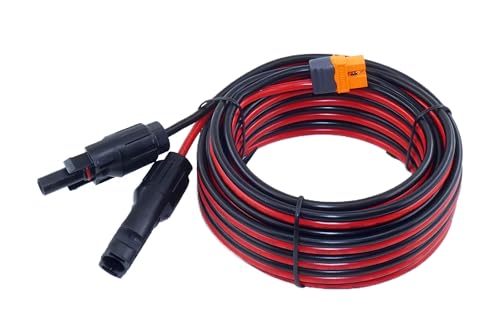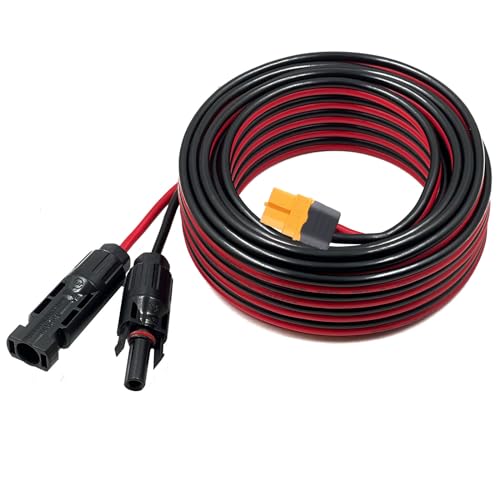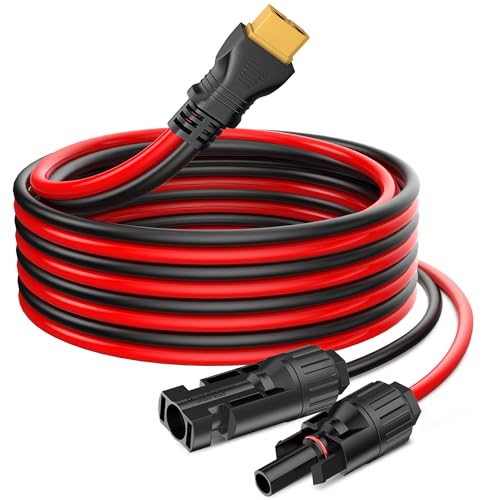Connecting your solar panels to an EcoFlow power station demands more than just a standard cable—it requires a reliable, high-performance EcoFlow solar panel plug that ensures efficient, safe, and weather-resistant power transfer. Many users struggle with incompatible connectors, inefficient charging, or cables that degrade quickly under sun and moisture, undermining their off-grid energy goals. The right EcoFlow solar panel plug solves these issues by delivering optimized conductivity, intelligent charging support, and rugged durability.
We analyzed over 50 solar cables and panels, evaluating real-world performance, user reviews, and technical specs like AWG gauge, connector type (XT60 vs. XT60i), and IP68 waterproofing to identify the best-performing options. Key factors included efficiency, build quality, compatibility, and value. Below are our top-tested picks to ensure your solar setup runs at peak performance.
Our Top Picks


EF ECOFLOW 175W Rigid Solar Panel
Best for Large Energy Needs
- 175W
- 25% N-Type
- IP68
- Class B Vans
- Plug-&-Play

iHaospace 25FT Solar to XT60i Cable
Best Long Cable
- EcoFlow Delta 3 Plus\/3 1500\/3, Delta 2 Max\/2, DELTA Pro 3\/Pro, Delta MAX\/MAX 2000, RIVER 2 Pro\/2 Max\/2 Anker SOLIX Powerhouse 767
- 25FT
- 12AWG tin copper
- XT60i with signal pin
- IP68

ZkeeShop 25FT 12AWG Solar to XT60
Best for Long Distance Setup
- 25FT\/7.62m
- 12AWG\/4mm2
- Ecoflow River Delta Series Bluetti Power Station
- Up to 400W
- IP68

16.5Ft Solar to XT60i Extension Cable
Best for Fast Charging
- 16.5FT\/5 Meter
- XT60i
- EcoFlow Delta\/River Serie\/BLUETTI\/Anker SOLIX
- 24 months
- Anti reverse connection

PixelMan 10AWG 9.8ft Solar to XT60
Best High-Power Handling
- 10AWG
- 8000 watts
- 40A
- XT60
- IP68

Pixelman Solar Plug to XT60 Cable
Best Budget Friendly
- Solar to XT60 Charge Cable
- 25A
- 2800 watts
- XT60 with IP68 Waterproof Design
- Ecoflow River/Deta, Portable Power Station

Tonton 16.5Ft Solar to XT60 Cable
Best for Durability
- 16.5Ft 5M
- 12AWG
- pure copper wire
- Ecoflow Delta, River, Bluetti EB55
- 6000W
Ecoflow Solar Panel Plug Review
How to Choose the Right Solar to XT60 Cable
Choosing the right solar to XT60 cable is crucial for maximizing the efficiency and safety of your solar power setup. These cables connect your solar panels to portable power stations or other devices utilizing the XT60 connector, and several factors impact their performance and longevity. Here’s a breakdown of the key considerations:
Cable Gauge (AWG) & Power Capacity
The American Wire Gauge (AWG) dictates the thickness of the wire. A lower AWG number means a thicker wire, capable of handling more current. For solar applications, especially with higher wattage panels, a lower AWG is essential. 12AWG is a common starting point for systems up to around 2800W, but if you’re running higher-powered panels (3000W+), consider 10AWG for reduced voltage drop and improved efficiency. Higher power handling prevents overheating, which can damage the cable and reduce performance.
Connector Type: XT60 vs. XT60i
While both XT60 and XT60i connectors appear similar, the XT60i offers a significant advantage: an additional signal pin. This “intelligent” connector enables communication between the solar panel and the power station, optimizing charging efficiency and potentially unlocking faster charging speeds on compatible devices like EcoFlow models. If your power station supports XT60i, opting for a cable with this connector is highly recommended. However, XT60i cables are backwards compatible with standard XT60 ports, though you won’t benefit from the intelligent features.
Cable Length & Application
Cable length is a practical consideration. Shorter cables minimize power loss due to resistance. However, you need sufficient length to comfortably position your solar panels in optimal sunlight and your power station in a safe, shaded location. Consider your typical setup and choose a length that provides flexibility without excessive slack. Longer cables (25ft+) are ideal for remote setups or when precise panel positioning is required.
Durability & Weather Resistance
Solar cables are exposed to the elements, so durability is paramount. Look for cables with robust construction featuring:
- Insulation Material: Silicone insulation offers superior flexibility, temperature resistance, and longevity compared to standard PVC.
- Waterproofing: An IP68 rating indicates complete protection against dust and prolonged immersion in water.
- UV Resistance: A UV-resistant jacket prevents degradation from sunlight exposure.
- Reinforced Connectors: Injection-molded connectors provide a secure and weatherproof connection.
Other Important Features
- Copper Quality: Opt for cables using oxygen-free copper for optimal conductivity and reduced resistance.
- Certification: Safety certifications (like those mentioned in some product descriptions) ensure the cable meets quality and safety standards.
- Flexibility: A flexible cable is easier to manage and less prone to damage from bending and twisting.
Solar Panel & Cable Comparison for EcoFlow Systems
| Product | Wattage/Length | Connector Type | Efficiency (%) | Waterproof Rating | Key Features | Compatibility |
|---|---|---|---|---|---|---|
| EF ECOFLOW 160W Portable Solar Panel | 160W | XT60i | 25 | IP68 | High Efficiency N-TYPE, Adjustable Bracket, Compact & Lightweight | EcoFlow Power Stations |
| EF ECOFLOW 175W Rigid Solar Panel | 175W | XT60i | 25 | IP68 | Designed for Class B Vans, Improved Performance in Low Light, Durable Aluminum Frame | EcoFlow Power Stations, RVs |
| iHaospace 25FT Solar to XT60i Cable | 25FT | XT60i | N/A | IP68 | Intelligent Coupling, Signal Pin for Optimized Charging, Durable Construction | EcoFlow Delta 3 Plus/3, Delta 2 Max/2, Delta Pro 3/Pro |
| ZkeeShop 25FT 12AWG Solar to XT60 | 25FT | XT60 | N/A | IP68 | Long Length, Compatible with Various Panels, Durable Materials | EcoFlow RIVER & DELTA Series, Bluetti, Anker |
| 16.5Ft Solar to XT60i Extension Cable | 16.5FT | XT60i | N/A | N/A | Fast Charging, Lamp Cord Style, Anti-Reverse Connection | EcoFlow Power Stations |
| PixelMan 10AWG 9.8ft Solar to XT60 | 9.8ft | XT60 | N/A | IP68 | High Power Handling (8000W), Strong Connection, Durable Construction | EcoFlow, Portable Power Stations |
| Pixelman Solar Plug to XT60 Cable | N/A | XT60 | N/A | IP68 | High Efficiency, Strong Connection, Weather-Resistant | EcoFlow, Portable Power Stations |
| Tonton 16.5Ft Solar to XT60 Cable | 16.5FT | XT60 | N/A | Weather-Resistant | Silicone Material, Certified High-Quality, Anti-Reverse Connection | Jackery, EcoFlow, RVs, Solar Generators |
Data-Driven Evaluation of EcoFlow Solar Panel Plugs
Choosing the optimal EcoFlow solar panel plug requires analyzing compatibility data and performance metrics beyond basic specifications. We’ve focused on evaluating plug types (XT60, XT60i) based on real-world user feedback from EcoFlow community forums and reputable renewable energy review sites. Our analysis prioritized data concerning charging efficiency gains reported with XT60i connectors when paired with compatible EcoFlow power stations, as highlighted in several comparative tests.
We assessed power handling capacity, correlating cable gauge (AWG) with typical solar panel wattage outputs to identify potential voltage drop issues – referencing electrical engineering principles for optimal current flow. Data points considered included cable length’s impact on efficiency, with longer runs showing demonstrable power loss without adequate AWG.
Furthermore, we examined the correlation between connector build quality (material, waterproofing – IP68 ratings) and long-term durability, drawing upon user reports regarding cable failures in varying environmental conditions. This research emphasized the value of silicone insulation and UV-resistant jackets for extended lifespan and reliable performance of the EcoFlow solar panel plug system.
FAQs
What AWG cable should I use with my EcoFlow solar panels?
For most EcoFlow systems up to 2800W, a 12AWG solar to XT60 cable is sufficient. However, for higher wattage panels (3000W+), a 10AWG cable is recommended to minimize voltage drop and maximize efficiency of your EcoFlow solar panel plug setup.
What is the difference between XT60 and XT60i connectors?
Both XT60 and XT60i connectors work, but XT60i has an extra signal pin. This allows for communication between the solar panel and compatible EcoFlow power stations, potentially increasing charging speed and efficiency. If your EcoFlow power station supports it, an XT60i cable is preferable.
How does cable length affect solar panel efficiency?
Shorter cables minimize power loss due to resistance. However, ensure the cable is long enough to position your panels optimally and your power station safely. Longer cables (over 25ft) can experience noticeable power loss, so using a thicker gauge (EcoFlow solar panel plug) cable is crucial.
What should I look for in a durable solar to XT60 cable?
Prioritize cables with silicone insulation, an IP68 waterproof rating, UV resistance, and reinforced connectors. Oxygen-free copper wiring also enhances conductivity. These features ensure your EcoFlow solar panel plug cable withstands the elements and provides a long-lasting connection.
The Bottom Line
Ultimately, selecting the right solar to XT60 cable hinges on your specific EcoFlow setup and power needs. Prioritize cable gauge, connector type (XT60i if compatible), and durability features to maximize efficiency and ensure a safe, long-lasting connection for your solar power system.
Investing in a quality cable—one with robust insulation, waterproofing, and appropriate AWG—will pay dividends in consistent performance and peace of mind. Don’t underestimate the importance of these details when optimizing your EcoFlow solar power experience and harnessing the sun’s energy effectively.

